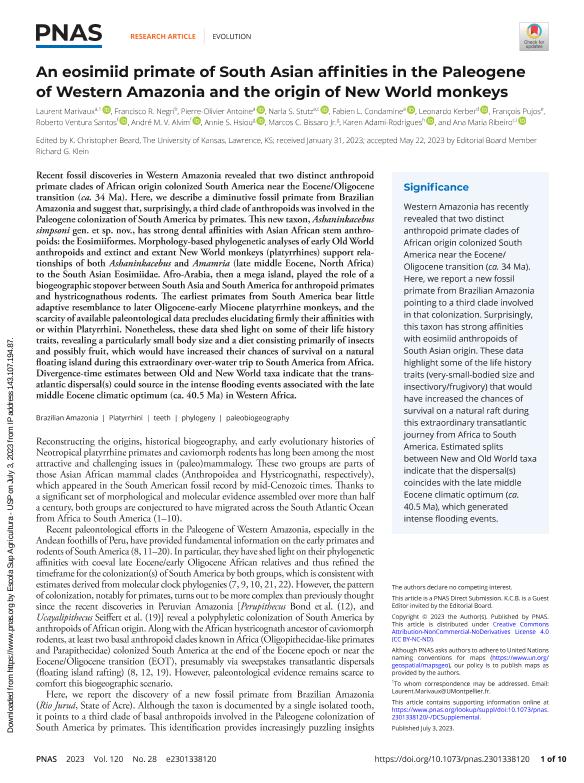Artículo
An eosimiid primate of South Asian affinities in the Paleogene of Western Amazonia and the origin of New World monkeys
Marivaux, Laurent; Negri, Francisco; Antoine, Pierre Olivier; Stutz, Narla S.; Condamine, Fabien; Kerber, Leonardo; Pujos, François Roger Francis ; Ventura Santos, Roberto; Alvim, André M. V.; Hsiou, Annie S.; Bissaro Jr., Marcos C.; Adami Rodrigues, Karen; Ribeiro, Ana Maria
; Ventura Santos, Roberto; Alvim, André M. V.; Hsiou, Annie S.; Bissaro Jr., Marcos C.; Adami Rodrigues, Karen; Ribeiro, Ana Maria
 ; Ventura Santos, Roberto; Alvim, André M. V.; Hsiou, Annie S.; Bissaro Jr., Marcos C.; Adami Rodrigues, Karen; Ribeiro, Ana Maria
; Ventura Santos, Roberto; Alvim, André M. V.; Hsiou, Annie S.; Bissaro Jr., Marcos C.; Adami Rodrigues, Karen; Ribeiro, Ana Maria
Fecha de publicación:
03/07/2023
Editorial:
National Academy of Sciences
Revista:
Proceedings of the National Academy of Sciences of The United States of America
ISSN:
0027-8424
e-ISSN:
1091-6490
Idioma:
Inglés
Tipo de recurso:
Artículo publicado
Clasificación temática:
Resumen
Recent fossil discoveries in Western Amazonia revealed that two distinct anthropoidprimate clades of African origin colonized South America near the Eocene/Oligocenetransition (ca. 34 Ma). Here, we describe a diminutive fossil primate from BrazilianAmazonia and suggest that, surprisingly, a third clade of anthropoids was involved in thePaleogene colonization of South America by primates. This new taxon, Ashaninkacebussimpsoni gen. et sp. nov., has strong dental affinities with Asian African stem anthropoids:the Eosimiiformes. Morphology-based phylogenetic analyses of early Old Worldanthropoids and extinct and extant New World monkeys (platyrrhines) support relationshipsof both Ashaninkacebus and Amamria (late middle Eocene, North Africa) to the South Asian Eosimiidae. Afro-Arabia, then a mega island, played the role of a biogeographic stopover between South Asia and South America for anthropoid primates and hystricognathous rodents. The earliest primates from South America bear little adaptive resemblance to later Oligocene-early Miocene platyrrhine monkeys, and the scarcity of available paleontological data precludes elucidating firmly their affinities with or within Platyrrhini. Nonetheless, these data shed light on some of their life history traits, revealing a particularly small body size and a diet consisting primarily of insectsand possibly fruit, which would have increased their chances of survival on a natural floating island during this extraordinary over-water trip to South America from Africa. Divergence-time estimates between Old and New World taxa indicate that the transatlantic dispersal(s) could source in the intense flooding events associated with the late middle Eocene climatic optimum (ca. 40.5 Ma) in Western Africa.
Palabras clave:
Brazilian Amazonia
,
Platyrrhini
,
Teeth
,
Phylogeny
Archivos asociados
Licencia
Identificadores
Colecciones
Articulos(IANIGLA)
Articulos de INST. ARG. DE NIVOLOGIA, GLACIOLOGIA Y CS. AMBIENT
Articulos de INST. ARG. DE NIVOLOGIA, GLACIOLOGIA Y CS. AMBIENT
Citación
Marivaux, Laurent; Negri, Francisco; Antoine, Pierre Olivier; Stutz, Narla S.; Condamine, Fabien; et al.; An eosimiid primate of South Asian affinities in the Paleogene of Western Amazonia and the origin of New World monkeys; National Academy of Sciences; Proceedings of the National Academy of Sciences of The United States of America; 120; 28; 3-7-2023; 1-10
Compartir
Altmétricas



